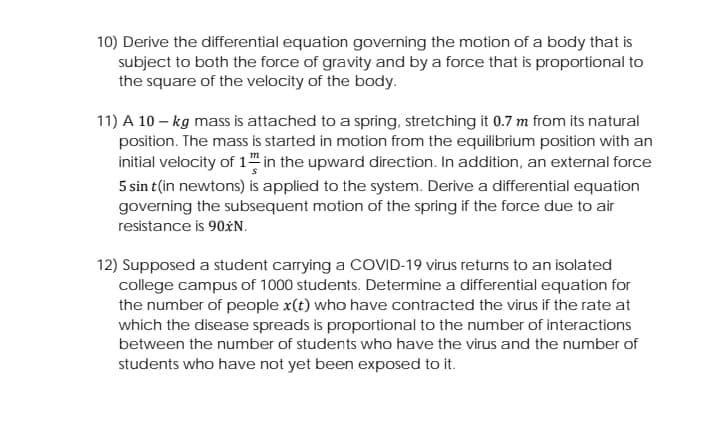10) Derive the differential equation governing the motion of a body that is subject to both the force of gravity and by a force that is proportional to the square of the velocity of the body.
10) Derive the differential equation governing the motion of a body that is subject to both the force of gravity and by a force that is proportional to the square of the velocity of the body.
Principles of Physics: A Calculus-Based Text
5th Edition
ISBN:9781133104261
Author:Raymond A. Serway, John W. Jewett
Publisher:Raymond A. Serway, John W. Jewett
Chapter6: Energy Of A System
Section: Chapter Questions
Problem 26P
Related questions
Question

Transcribed Image Text:10) Derive the differential equation governing the motion of a body that is
subject to both the force of gravity and by a force that is proportional to
the square of the velocity of the body.
11) A 10 – kg mass is attached to a spring, stretching it 0.7 m from its natural
position. The mass is started in motion from the equilibrium position with an
initial velocity of 1 in the upward direction. In addition, an external force
5 sin t(in newtons) is applied to the system. Derive a differential equation
governing the subsequent motion of the spring if the force due to air
resistance is 90*N.
12) Supposed a student carrying a COVID-19 virus returns to an isolated
college campus of 1000 students. Determine a differential equation for
the number of people x(t) who have contracted the virus if the rate at
which the disease spreads is proportional to the number of interactions
between the number of students who have the virus and the number of
students who have not yet been exposed to it.
Expert Solution
This question has been solved!
Explore an expertly crafted, step-by-step solution for a thorough understanding of key concepts.
Step by step
Solved in 2 steps with 2 images

Recommended textbooks for you

Principles of Physics: A Calculus-Based Text
Physics
ISBN:
9781133104261
Author:
Raymond A. Serway, John W. Jewett
Publisher:
Cengage Learning

College Physics
Physics
ISBN:
9781938168000
Author:
Paul Peter Urone, Roger Hinrichs
Publisher:
OpenStax College


Principles of Physics: A Calculus-Based Text
Physics
ISBN:
9781133104261
Author:
Raymond A. Serway, John W. Jewett
Publisher:
Cengage Learning

College Physics
Physics
ISBN:
9781938168000
Author:
Paul Peter Urone, Roger Hinrichs
Publisher:
OpenStax College


University Physics Volume 1
Physics
ISBN:
9781938168277
Author:
William Moebs, Samuel J. Ling, Jeff Sanny
Publisher:
OpenStax - Rice University